- Home
- Technical Cooperation Projects
- Index of Countries
- Africa
- Mozambique
- Project on Strengthening Resilience in Cyclone IDAI-Affected Areas
- Project News
- The 1st training in Japan - Observed the implementation of Japanese countermeasures against disasters and renewed resolution towards post-training activities -
Project News
2020-04-30
The 1st training in Japan - Observed the implementation of Japanese countermeasures against disasters and renewed resolution towards post-training activities -
From Feb. 25 to 27, 2020, the participants visited Kamisu City and Kashima Coastline in Ibaraki Prefecture as well as Katsushika City and Edogawa City in Tokyo to learn what kind of measures are taken on disasters such as flooding, storm surge, and coastal erosion. On the final training day, Feb. 28, 2020, the participants presented post-training action plans, which they will work on after returning to Mozambique.
Disaster risk reduction countermeasures in coastal area and coastal protection efforts in Ibaraki Prefecture (Feb. 25, 2020)
The participants received a lecture on coastal protection efforts in the Kashimanada Sea Coast from Mr. Shogo Kikuchi from River Section, Civil Engineering Department, Ibaraki Prefectural Government Office, and subsequently visited a coastal protection facility to grasp the development status with headland construction method and a venue for artificial beach nourishment with coarse-grained materials. Because the Beira Municipality faces the challenge of beach erosion, the participants intriguingly observed the facility development status.
In the afternoon, Mr. Takahiro Yasui from Disaster Prevention and Safety Section, Life Environment Department, Kamisu City Office, Ibaraki Prefecture, introduced the facility functions on Kamisu City Hasaki General Branch and Disaster Risk Reduction Center, which were built as a local disaster risk reduction base. Because the Beira Municipality has considered evacuation center management and necessary equipment, the participants were very interested in knowing the facility development status.
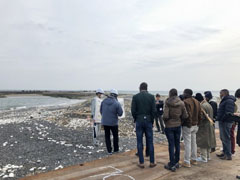 Onsite visit to coastal protection facility. The black sand in the foreground indicates coarse-grained materials scattered for artificial beach nourishment, together with the coastal protection facility with headland construction method in the background.
Onsite visit to coastal protection facility. The black sand in the foreground indicates coarse-grained materials scattered for artificial beach nourishment, together with the coastal protection facility with headland construction method in the background.
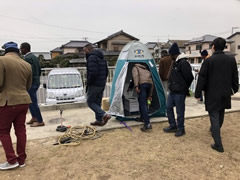 Jose was observing the manhole-style bathroom with interest, which was installed in the site of the Kamisu City Hasaki General Branch and Disaster Prevention Center.
Jose was observing the manhole-style bathroom with interest, which was installed in the site of the Kamisu City Hasaki General Branch and Disaster Prevention Center.
Promotion of disaster risk reduction activity collaboration between industry, government and academia in Katsushika City (in the morning of Feb. 26, 2020)
A seminar was held in Katsushika City to share knowledge collected by persons involved in the promotion of disaster risk reduction activities under the residents' initiative. The lectures were provided by Professor Takaaki Kato from the Institute of Industrial Science, the University of Tokyo and an NPO representative from Ah! Safety/Comfortable Town Development, and representatives from Shin-Koiwa 7-chome Town Association.
After the participants understood the activity status in Katsushika City, they filled out and produced their own "My Timeline" based on the manual in order to grasp the required disaster risk reduction activities in the community.
As there are few cases on disaster activities under the collaboration between the university and private sector in Mozambique, participants seemed very satisfied with this seminar, commenting that "This experience is useful as a reference for future disaster prevention activity in the country," and "Producing the actual My Timeline by myself was meaningful."
History of river improvement in Edogawa City (In the afternoon of Feb. 26, 2020)
Edogawa City has a history and experience of taking river improvement measures due to its high risks of storm surge and floods. Mr. Nobuyuki Tsuchiya from the Japan River Front Research Center, which was involved in river improvement infrastructure development in Edogawa City, led the study tour. Mr. Tsuchiya visited related facilities in the city with the participants and explained the background and history of river improvement measures. For example, the Edogawa City Office has raised the coastal levee to respond to challenges such as the change in expected typhoon scale and ground settlement. The participants also visited the former Kasai coastal levee, which was raised for disaster risk reduction, to learn about the background of infrastructure development. They were impressed by the trace of long-term fighting over flooding in Japan.
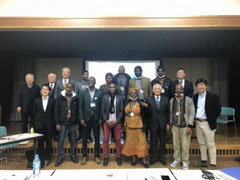 Group photo of the participants after the seminar in Katsushika City. The participants were extremely impressed by NPO staff (the neighborhood association) implementing volunteer work with enthusiasm.
Group photo of the participants after the seminar in Katsushika City. The participants were extremely impressed by NPO staff (the neighborhood association) implementing volunteer work with enthusiasm.
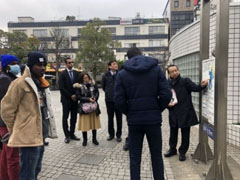 Mr. Tsuchiya from the Japan Riverfront Research Center (right) is briefing about land features at sea level in the watermark (right edge) installed in the square in front of Hirai Station, together with regional disaster risks. The height above sea level at this point indicates the dark blue description "AP +/- 0 m" in the signboard.
Mr. Tsuchiya from the Japan Riverfront Research Center (right) is briefing about land features at sea level in the watermark (right edge) installed in the square in front of Hirai Station, together with regional disaster risks. The height above sea level at this point indicates the dark blue description "AP +/- 0 m" in the signboard.
Action against strong wind caused by typhoon and cyclone (Feb. 27, 2020)
The lectured was given by Professor Tsuyoshi Seike from the Graduate School of Frontier Sciences, the University of Tokyo, about the background of Japan's building standards act and action against a strong wind. As Cyclone Idai devastated buildings with strong winds, the participants commented with interest that they wanted to consider building standards act in Mozambique based on the Japanese act.
Presentation on action plan made by participants (Feb. 28, 2020)
On the final training day, after presenting their own action plans, the evaluation workshop on this training was held, and the participants received a certificate of completion. In the presentation, they delivered specific future action plans in Mozambique based on knowledge learned and experience of the training. They also promised that they should closely collaborate with the JICA project in future activities and advance action across Beira City and Mozambique.
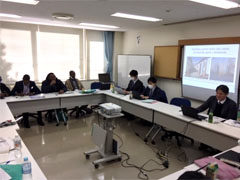 Lecture given by Professor Seike.
Lecture given by Professor Seike.
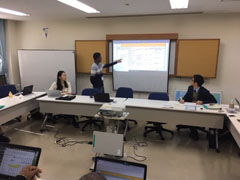 Trainee delivering presentation on action plan.
Trainee delivering presentation on action plan.
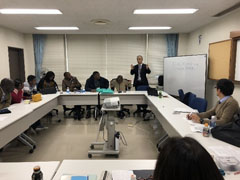 Exchanging opinions in the evaluation workshop.
Exchanging opinions in the evaluation workshop.
- Highlights -
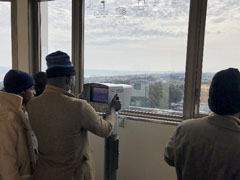 Participants observing the coastline protection facility from the observation deck overlooking the sea. Participants are interested in a telescope and enjoyed viewing the landscape, reliving their childhood. As Beira City is located along the sea, citizens love viewing the sea. The participants went close to he seaside and enjoyed the landscape cheerfully like a child.
Participants observing the coastline protection facility from the observation deck overlooking the sea. Participants are interested in a telescope and enjoyed viewing the landscape, reliving their childhood. As Beira City is located along the sea, citizens love viewing the sea. The participants went close to he seaside and enjoyed the landscape cheerfully like a child.
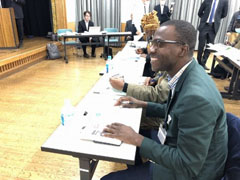 Sérgio is filling out his own activities at the disaster in line with My Timeline production manual at the seminar. The participants enjoyed learning "My Timeline" in a workshop style.
Sérgio is filling out his own activities at the disaster in line with My Timeline production manual at the seminar. The participants enjoyed learning "My Timeline" in a workshop style.
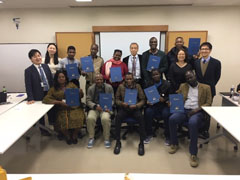 Group photo of the participants finishing the training course successfully with the certificates in hand, praising each other and saying "Parabéns!!," meaning congratulations in Portuguese.
Group photo of the participants finishing the training course successfully with the certificates in hand, praising each other and saying "Parabéns!!," meaning congratulations in Portuguese.
Post-training Story: One-year commemoration event for Cyclone Idai
One of the lessons learned in the training is "Passing disaster experiences on to future generation." Based on this lesson and on a monumental stone that the participants visited in a disaster reconstruction memorial park, they built a monument in Beira City and unveiled it at the one-year commemoration event of Cycle Idai on March 14, 2020.
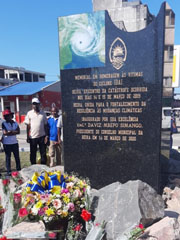 Monument for Cyclone Idai. The participants from the Beira Municipality completed the installation of the monument just two weeks after returning home.
Monument for Cyclone Idai. The participants from the Beira Municipality completed the installation of the monument just two weeks after returning home.
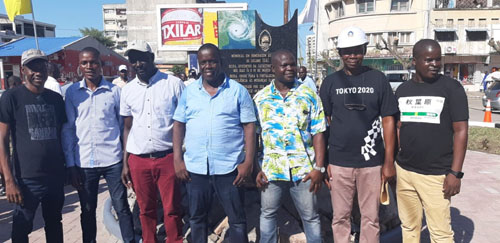 Participants with the mayor (center) in front of the monument.
Participants with the mayor (center) in front of the monument.
- About JICA
- News & Features
- Countries & Regions
- Our Work
- Thematic Issues
- Types of Assistance
- Partnerships with Other Development Partners
- Climate Change / Environmental and Social Considerations
- Evaluations
- Compliance and Anti-corruption
- Science and Technology Cooperation on Global Issues
- Research
- JICA Development Studies Program / JICA Chair
- Support for the Acceptance of Foreign HRs / Multicultural and Inclusive Community
- Publications
- Investor Relations
